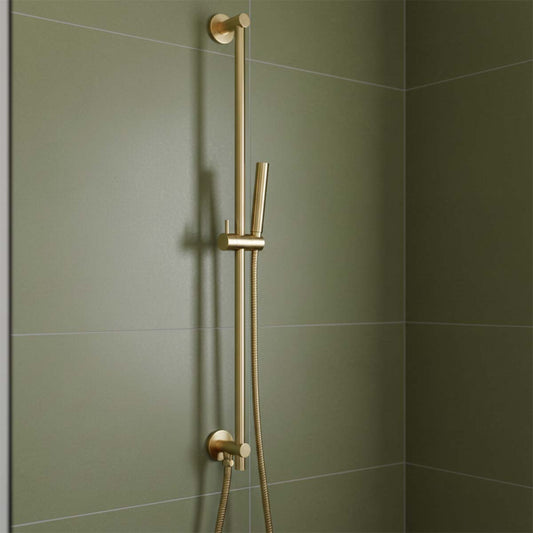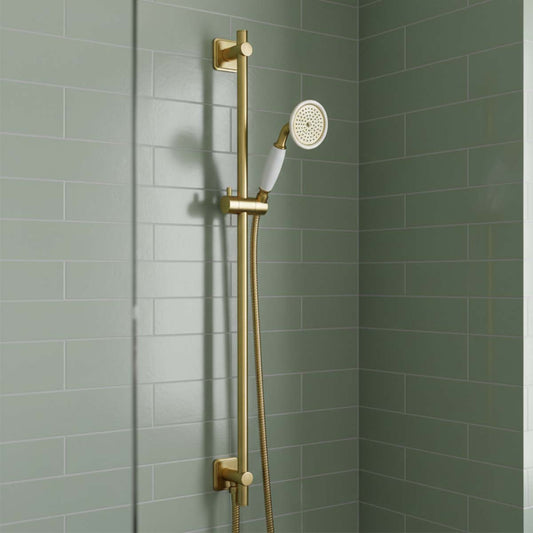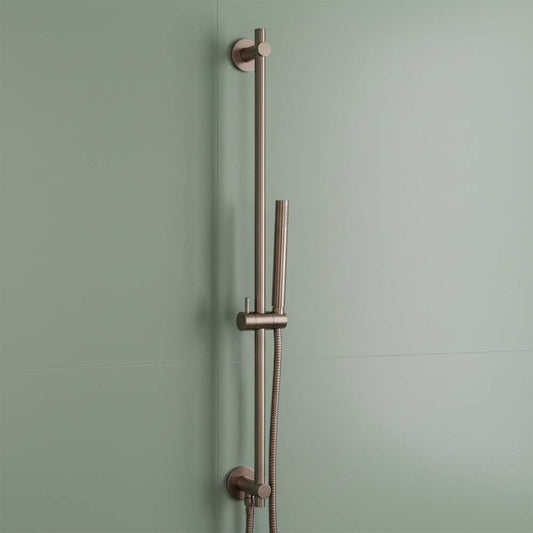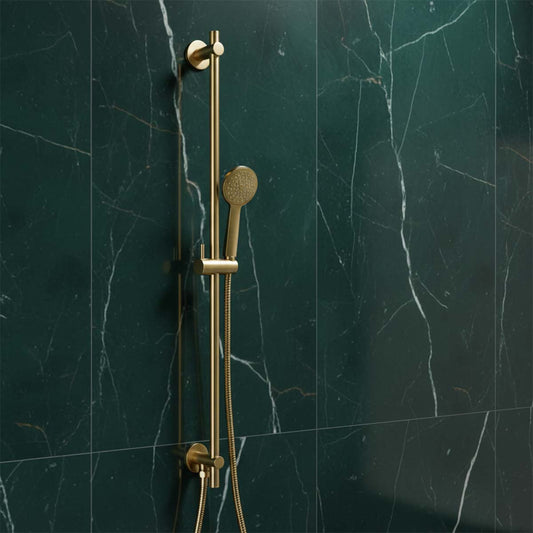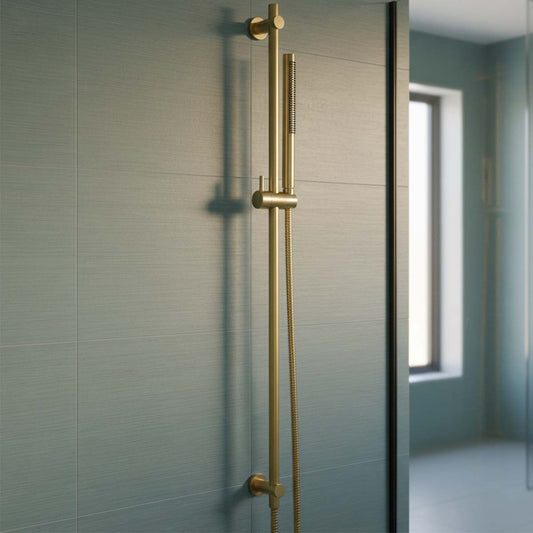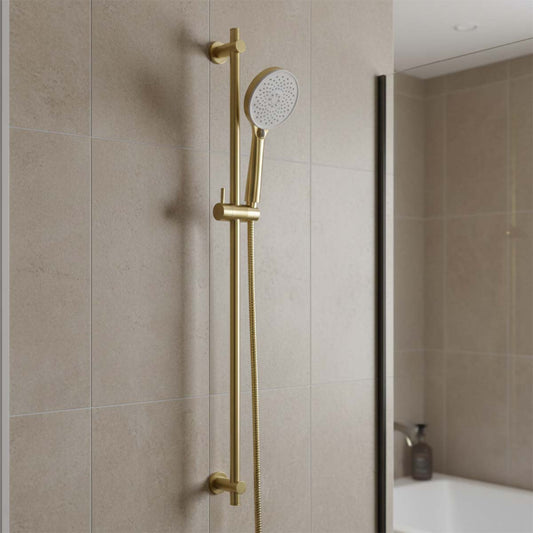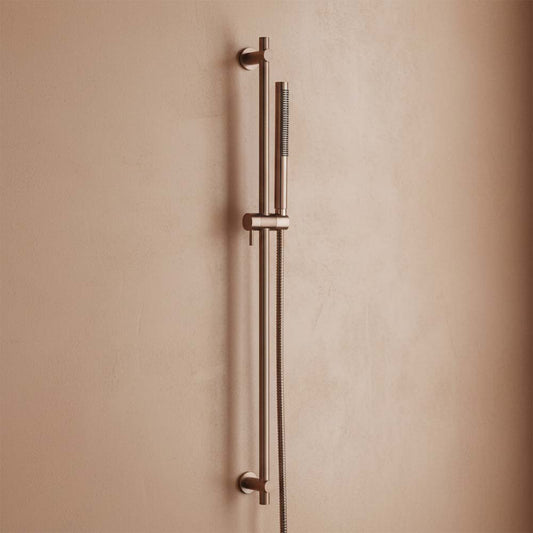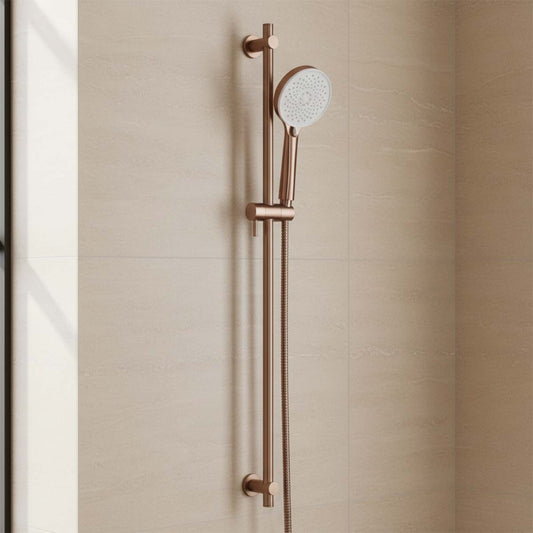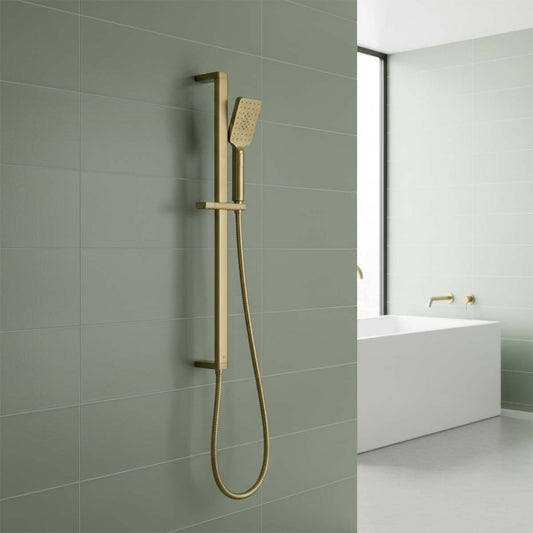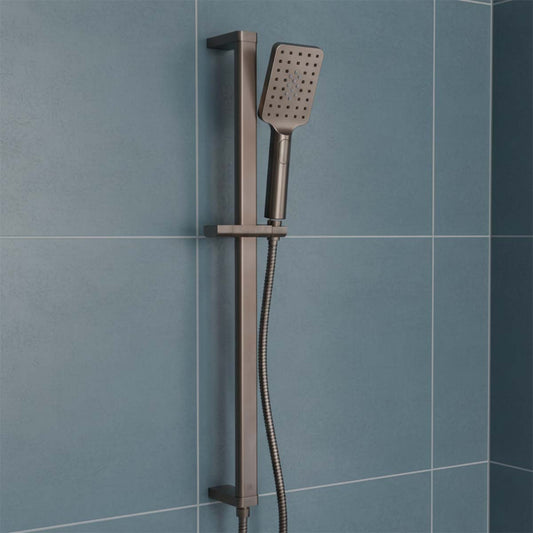The Ultimate Guide to Tackling Limescale in Your Bathroom
Table Of Contents:
-
Introduction
-
What is Limescale?
-
How Harmful Is Limescale?
-
Why Does It Affect Your Bathroom?
-
How Limescale Affects Your Shower Fixtures
-
Effective Ways to Tackle Limescale in Your Gold Bathroom
-
Best Methods for Effectively Cleaning Limescale from Your Gold Bathroom Fixtures
-
Natural vs. Chemical Cleaners for Limescale Removal in Your Gold Bathroom
-
Prevention Measures to Keep Limescale at Bay in Your Gold Bathroom
-
Choosing the Right Products for Your Gold Bathroom
-
The Cost of Removing Limescale from Your Gold Bathroom
-
Conclusion
-
FAQs
Introduction
A gold bathroom is a statement of luxury, sophistication, and style. The golden fixtures, whether taps, showerheads, or towel bars, create a timeless and glamorous aesthetic that adds a sense of opulence to your space. However, this elegance can be tarnished by an all-too-common problem in UK bathrooms: limescale build-up. Hard water, a prevalent issue in many areas of the UK, can leave behind unsightly deposits that dull the finish of your precious gold fixtures. The good news is that with the right care and cleaning techniques, you can keep your gold bathroom looking as stunning as the day it was installed. In this ultimate guide, we’ll help you understand the causes of limescale, how it affects your gold bathroom, and the most effective ways to tackle it.
What is Limescale?
Limescale is a hard, chalky deposit that forms when water with a high mineral content, particularly calcium and magnesium, evaporates. These minerals are naturally present in water, and when it evaporates, the minerals are left behind on surfaces, creating a visible build-up. Limescale commonly appears as a white, cloudy, or crusty residue on surfaces that come into frequent contact with water, such as taps, showerheads, tiles, and glass in the bathroom.
Limescale is particularly prevalent in areas with hard water, which is water that has a high concentration of dissolved minerals. In the UK, many regions experience hard water, which is why limescale build-up is a common issue in many households. It not only affects the aesthetic of bathroom fixtures but can also cause blockages in pipes and reduce water flow in appliances like boilers and kettles, making it a problem for both maintenance and appearance.
How Harmful Is Limescale?
Limescale may seem like a minor inconvenience, but it can be quite harmful, both to your bathroom fixtures and your plumbing system. Here's why:
-
Aesthetic Damage
Limescale is particularly noticeable on shiny surfaces like gold, chrome, and glass, where it leaves behind white, chalky streaks and deposits. Over time, if not cleaned properly, it can dull the finish of your fixtures, causing them to lose their lustre and shine. In gold bathrooms, this can result in tarnishing, making your luxurious fixtures look outdated or dirty. -
Long-Term Surface Damage
If left untreated, limescale can be abrasive, gradually wearing away at the surface of your bathroom fixtures. The build-up can create rough patches on taps, showerheads, and tiles, leading to scratches and even permanent damage to delicate finishes, such as gold plating. This damage can be costly to repair or replace. -
Plumbing Blockages
One of the more serious consequences of limescale build-up is its effect on plumbing systems. Over time, limescale can accumulate inside pipes, taps, and water heaters, causing blockages and restricting water flow. This can result in reduced water pressure and inefficient operation of household appliances. In severe cases, the build-up of limescale can lead to costly repairs or even the need for replacing plumbing components. -
Reduced Efficiency of Appliances
Limescale deposits in appliances like boilers, dishwashers, and kettles can reduce their efficiency by clogging internal mechanisms and heat exchangers. This forces appliances to work harder to perform the same tasks, leading to increased energy consumption, higher utility bills, and potentially shortening their lifespan. -
Potential Health Concerns
While limescale itself is not harmful to health, the minerals in hard water, particularly calcium and magnesium, can build up in the body over time if consumed in large amounts. However, it's important to note that this is more of a concern for areas with extreme hardness. In typical household settings, limescale build-up is primarily a cosmetic and maintenance issue, rather than a direct health hazard.
Why Does It Affect Your Bathroom?
Limescale is particularly problematic for gold bathrooms due to the unique properties of gold finishes. Gold-plated or gold-coated fixtures are delicate and designed to maintain a gleaming, luxurious appearance, but limescale can easily disrupt this. Here’s why limescale has such a significant impact on your gold bathroom:
-
Adheres to Gold Surface
Gold bathroom fixtures, while durable, are often coated with a thin layer of gold plating. Limescale, being a mineral deposit, easily clings to these surfaces, creating unsightly white streaks and patches that dull the luster of gold. Over time, these deposits can cause the gold finish to look discolored, reducing the visual appeal of your elegant bathroom fixtures. -
Risk of Tarnishing
Gold plating is known for its shiny, reflective surface. Limescale build-up can cause the finish to look cloudy and discoloured, leading to tarnishing. While gold itself doesn’t rust, the combination of mineral build-up and moisture can damage the underlying gold layer, leading to permanent discoloration or fading of the fixture’s original gold hue. -
Difficult to Remove from Delicate Gold Finishes
Gold is a relatively soft metal, and the thin plating that covers bathroom fixtures is even more prone to scratches and wear. When limescale accumulates, removing it can be tricky. Harsh scrubbing or abrasive cleaning methods can scratch the gold surface, making it even more vulnerable to future build-up and permanent damage. Therefore, cleaning gold fixtures requires extra care, as improper methods can worsen the condition. -
Aesthetic and Maintenance Challenge
In a gold bathroom, the luxurious finish is one of the key design features. The shiny, reflective surfaces of gold fixtures are meant to create a sense of opulence. When limescale settles on these pieces, it disrupts the entire look, making it appear dirty, aged, or neglected. This creates an aesthetic challenge as regular cleaning becomes essential to maintain the golden shine and beauty of the bathroom. -
Impact on Gold’s Durability
The acidic nature of limescale cleaners can also damage the gold plating if used incorrectly. While some cleaning agents are designed to dissolve limescale, they may be too harsh for gold-plated finishes, leading to premature deterioration of the gold layer. Over time, the cumulative effects of exposure to hard water and improper cleaning can cause the gold to degrade, reducing the lifespan of your fixtures.

How Limescale Affects Your Shower Fixtures
Gold fixtures in the bathroom bring an undeniable touch of elegance and luxury to your space. However, the delicate nature of gold finishes makes them particularly vulnerable to limescale build-up. Here's a closer look at how limescale affects your gold fixtures:
-
Cloudy and Dull Appearance
Limescale deposits can quickly dull the bright, polished look of your gold fixtures. The minerals in hard water, particularly calcium and magnesium, leave behind white, chalky spots when they evaporate. Over time, these deposits accumulate on gold surfaces, resulting in a cloudy or frosted appearance that detracts from the fixture's natural shine and luster. This can make your gold bathroom fixtures look old, neglected, or dirty, even if they are well-maintained. -
Permanent Staining
If left untreated for too long, limescale can stain gold fixtures. The minerals that form limescale can bond strongly to the surface of gold, and the longer they stay in contact with the metal, the more difficult they are to remove. In extreme cases, limescale can cause permanent discoloration or a buildup that may eventually damage the gold finish itself. This is especially concerning for high-end gold-plated fixtures, as it can lower their aesthetic appeal and value. -
Surface Scratching and Abrasive Damage
Gold finishes, particularly gold plating, are relatively soft compared to other materials. Limescale can create rough patches or accumulate in crevices, and if cleaned improperly with harsh abrasives or scrubbing tools, it can scratch or wear down the gold surface. Even seemingly gentle cleaning methods, if done too aggressively, can cause micro-scratches that dull the gold finish. This leads to a compromised surface, making it even more vulnerable to future build-up. -
Affecting the Longevity of Gold Fixtures
Gold-plated fixtures have a protective gold layer over a base metal, and if limescale build-up is not managed properly, it can weaken this layer. In severe cases, limescale can cause the gold plating to peel or corrode. As the base metal underneath becomes exposed, the fixture's durability and visual appeal are compromised, resulting in costly repairs or replacements. -
Increased Maintenance Effort
Gold bathroom fixtures require special care, as their smooth and polished finish can easily be damaged. Limescale build-up increases the frequency of cleaning required to keep the fixtures looking their best. However, using the wrong cleaning products—such as harsh chemicals or abrasive scrubbers—can worsen the situation by further damaging the gold. As limescale deposits become more entrenched, removing them without causing harm to the finish becomes increasingly difficult. -
Aesthetic Imbalance in Your Bathroom
Your gold bathroom fixtures are often the focal point of the room, so limescale build-up can negatively affect the overall design. When gold taps, showerheads, and other features are clouded or streaked with mineral deposits, they no longer have the same visual impact. This imbalance can detract from the luxurious atmosphere you’ve worked to create, leading to a less cohesive and polished bathroom design.

Effective Ways to Tackle Limescale in Your Gold Bathroom
Limescale is a common problem in bathrooms with hard water, and it can be particularly tricky to deal with in a gold bathroom, where the aesthetics of your fixtures are paramount. However, there are effective methods for tackling limescale that can help preserve the beauty and longevity of your gold bathroom. Here are some of the best strategies for handling limescale build-up without damaging your gold fixtures:
1. Use Gentle, Non-Abrasive Cleaners
When tackling limescale in a gold bathroom, it's important to use non-abrasive cleaners to avoid damaging the delicate gold finish. Avoid harsh scrubbers or acidic cleaners that can scratch or tarnish the gold surface. Instead, opt for gentle, pH-balanced cleaners designed specifically for gold or delicate finishes. These cleaners are effective at breaking down mineral deposits without causing harm.
2. Vinegar Solution for Mild Limescale
Vinegar is a natural, non-toxic cleaner that works wonders in removing limescale, especially when diluted with water. Mix a 50/50 solution of white vinegar and water in a spray bottle and apply it to the affected areas. Let it sit for about 10-15 minutes to allow the vinegar to break down the limescale, then gently wipe away the residue using a soft cloth. Be sure to rinse the gold fixtures thoroughly with water to prevent any vinegar from lingering, as its acidity can potentially cause damage if left too long.
3. Limescale Removers for Gold Fixtures
There are specially formulated limescale removers on the market that are safe for use on gold fixtures. These products are designed to dissolve mineral deposits effectively without harming gold or other delicate finishes. When using these products, always follow the manufacturer’s instructions carefully, and test the cleaner on a small, inconspicuous area before applying it to larger surfaces. This ensures the cleaner won’t cause any discoloration or damage to your gold plating.
4. Regular Cleaning Routine
Preventing limescale build-up is always better than dealing with a severe problem later. Establishing a regular cleaning routine is essential to keep your gold bathroom fixtures looking their best. Wipe down taps, showerheads, and other gold surfaces after every use to prevent mineral deposits from accumulating. A quick wipe with a soft cloth can help maintain their shine and prevent stubborn limescale from taking hold.
5. Use a Soft Cloth or Sponge
When cleaning gold fixtures, always use a soft cloth or non-abrasive sponge to avoid scratching the surface. Avoid steel wool, scrubbing pads, or any rough material that could cause micro-scratches in the gold finish. These scratches can trap future limescale deposits, making it even harder to clean in the future. A microfiber cloth is ideal for gently wiping down fixtures while also providing a streak-free finish.
6. Water Softener Installation
To prevent limescale build-up in the first place, consider installing a water softener in your home. A water softener reduces the hardness of the water by removing calcium and magnesium, the minerals that cause limescale. This will not only reduce limescale accumulation but also extend the lifespan of your gold bathroom fixtures and other appliances by protecting them from mineral damage.
7. Lemon Juice for Stubborn Deposits
Lemon juice is another natural, mild acid that can help break down limescale. For more stubborn deposits, apply fresh lemon juice directly to the affected areas or use it in a diluted form. The acidity of lemon juice dissolves the mineral build-up, and its fresh scent leaves your bathroom smelling clean and pleasant. After using lemon juice, rinse the fixtures thoroughly with water to ensure no residue remains.
8. Polishing After Cleaning
Once the limescale has been removed, consider polishing your gold fixtures to restore their shine. Use a gold-safe polish designed for bathroom fixtures. Apply a small amount to a soft cloth, and buff the surface gently to bring back the gleam. Polishing will not only enhance the appearance but also provide a layer of protection that can make future cleaning easier.
9. Avoid Excessive Moisture
After cleaning, ensure your bathroom is well-ventilated and avoid excessive moisture build-up, which can accelerate limescale formation. Use an exhaust fan or open a window to promote air circulation and prevent condensation from settling on your gold fixtures. This will help keep your bathroom dry and reduce the likelihood of limescale deposits forming again.
By following these strategies, you can effectively tackle limescale in your gold bathroom, preserving the luxurious look of your fixtures while ensuring they remain in top condition. Regular maintenance, gentle cleaning methods, and preventative measures will go a long way in keeping your bathroom gleaming and free from harmful mineral deposits.

Best Methods for Effectively Cleaning Limescale from Your Gold Bathroom Fixtures
Cleaning limescale from your gold bathroom fixtures requires a careful and methodical approach to ensure that your gold finishes remain unharmed while removing mineral deposits. Below are the step-by-step cleaning methods you can follow for effective limescale removal:
1. Prepare Your Cleaning Solution
Start by preparing a gentle cleaning solution. You can use natural ingredients like white vinegar or lemon juice or opt for a store-bought, gold-safe limescale remover. Here’s how to prepare:
-
For vinegar: Mix equal parts white vinegar and water in a spray bottle.
-
For lemon juice: Dilute lemon juice with water in a 1:1 ratio.
-
For baking soda: Mix baking soda with water to create a thick paste.
If you're using a commercial cleaner, read the manufacturer’s instructions to ensure it’s safe for use on gold.
2. Apply the Cleaning Solution
Spray or apply the cleaning solution generously to the limescale-affected areas. Focus on areas where mineral deposits are most noticeable, such as taps, showerheads, and taps. Let the solution sit for about 10-15 minutes. This allows the acid in the vinegar or lemon juice to break down the minerals in the limescale, making it easier to remove.
3. Gently Scrub the Surface
Once the cleaning solution has had time to sit, use a soft cloth or a non-abrasive sponge to gently scrub the surface. Avoid using steel wool or abrasive pads, as these can scratch or damage the gold finish. For persistent spots, you can create a paste using baking soda and gently scrub it into the deposits with a cloth. Be careful not to apply too much pressure to avoid damaging the gold plating.
4. Rinse Thoroughly with Water
After scrubbing, rinse the affected areas thoroughly with warm water to remove all traces of the cleaning solution and loosened limescale. Ensure that no cleaning residue is left on the gold finish, as it could cause damage over time.
5. Dry and Polish
Once your gold fixtures are clean, dry them immediately using a soft, dry cloth. This step is crucial to avoid water spots or the formation of new limescale from any remaining moisture. To restore the gold’s shine, you can also polish the surface with a gold-safe polish or a microfiber cloth. Buff gently in circular motions to give your fixtures a gleaming finish.
6. Inspect for Remaining Limescale
After cleaning and polishing, take a moment to inspect your gold fixtures for any remaining traces of limescale. If any deposits persist, repeat the cleaning process on those areas. Sometimes, stubborn limescale requires a few rounds of treatment for complete removal.
7. Prevention for Future Build-Up
Once your fixtures are limescale-free, consider implementing measures to prevent future build-up. Wipe your fixtures dry after every use, especially in areas where water tends to accumulate. You may also want to install a water softener to reduce the hardness of the water and minimize limescale formation. Regular maintenance will keep your gold bathroom fixtures sparkling and free from mineral deposits.
By following these steps, you can maintain the beauty of your gold bathroom while effectively removing limescale and preserving your fixtures' luxurious shine.

Natural vs. Chemical Cleaners for Limescale Removal in Your Gold Bathroom
When it comes to tackling limescale in your gold bathroom, choosing the right cleaner is crucial. Both natural and chemical cleaners can be effective, but they come with their own set of pros and cons. Let’s explore the differences between these two options and help you decide which one is best for your gold fixtures.
Natural Cleaners: Gentle and Eco-Friendly
Natural cleaners, such as vinegar, lemon juice, and baking soda, are popular choices for cleaning limescale from gold bathroom fixtures. These cleaners are often seen as more eco-friendly and safe for use in homes with children or pets. Here’s why natural cleaners may be the preferred choice for many:
-
Gentle on Gold Fixtures: Natural cleaners are typically non-abrasive and less likely to cause damage to gold finishes when used correctly. They work by dissolving the mineral deposits in limescale without scratching or tarnishing the gold surface.
-
Non-Toxic and Environmentally Safe: Natural ingredients like vinegar and lemon juice are safe for both the environment and your health. They contain no harmful chemicals, making them ideal for homes that prioritize eco-friendly cleaning practices.
-
Cost-Effective: Many natural cleaners, like vinegar and baking soda, are inexpensive and readily available in most households. They offer a budget-friendly way to maintain your bathroom without sacrificing effectiveness.
-
Mild on Tough Limescale: While natural cleaners are effective on light limescale deposits, they may struggle with more stubborn or long-term build-ups. For heavily calcified areas, you may need to apply the solution multiple times, which can take more effort.
Chemical Cleaners: Powerful and Fast-Acting
Chemical cleaners, specifically designed for removing limescale, are typically stronger and faster-acting than natural alternatives. These cleaners contain active ingredients like hydrochloric acid or citric acid, which can break down mineral deposits more effectively. However, they come with certain considerations:
-
Stronger Action on Stubborn Limescale: Chemical cleaners are formulated to quickly dissolve limescale, even in cases of severe build-up. They can be particularly effective for persistent or long-standing deposits that natural cleaners might not remove in one application.
-
Potentially Harsh on Gold Fixtures: While effective on limescale, some chemical cleaners can be harsh on gold finishes if not used properly. Overuse or incorrect application can lead to discoloration, tarnishing, or even damage to the gold surface.
-
Health and Safety Risks: Many chemical cleaners contain potent ingredients that can irritate the skin, eyes, or respiratory system if inhaled. It’s important to wear gloves and work in a well-ventilated area when using these products. Additionally, some harsh chemicals can harm the environment if not disposed of correctly.
-
Convenience: Chemical cleaners are often designed to work quickly and require less time to sit on the surface compared to natural cleaners. For people looking for a faster solution, chemical cleaners can be a time-saving option.
Which Should You Choose?
Ultimately, the choice between natural and chemical cleaners depends on your specific needs and priorities:
-
If you're looking for a gentle, eco-friendly, and budget-conscious option, natural cleaners like vinegar, lemon juice, and baking soda are an excellent choice. They’re safe for gold finishes and help keep your bathroom free from harmful chemicals.
-
If you have heavily built-up limescale or need to remove tough stains quickly, a chemical cleaner designed for gold or delicate surfaces might be the more effective solution. Just be sure to use it cautiously and follow the manufacturer's instructions to avoid damage.
In either case, always test the cleaner on a small, inconspicuous area before using it on your entire fixture to ensure that it won’t cause any unwanted effects. Regular maintenance and prompt cleaning will go a long way in preventing significant limescale build-up, whether you choose a natural or chemical cleaner for the task.
Prevention Measures to Keep Limescale at Bay in Your Gold Bathroom
Limescale is a persistent problem in bathrooms, especially for those with hard water. While cleaning limescale from your gold bathroom fixtures is possible, the best solution is to prevent it from building up in the first place. By taking a few proactive steps, you can keep your gold fixtures looking pristine and reduce the frequency of cleaning. Here are some effective prevention measures to help you avoid limescale accumulation in your gold bathroom:
1. Install a Water Softener
One of the most effective ways to prevent limescale build-up in your bathroom is by installing a water softener. Water softeners remove calcium and magnesium—two minerals that cause hard water and lead to limescale build-up. By softening the water before it enters your plumbing system, you’ll significantly reduce mineral deposits in your bathroom. This is particularly helpful in areas with hard water, where limescale is more likely to form.

2. Wipe Down Fixtures After Use
A simple yet effective way to prevent limescale build-up is to wipe down your bathroom fixtures after each use. Water spots can quickly turn into mineral deposits if left to dry on your gold fixtures. By using a soft, dry cloth to wipe off excess water after each shower or bath, you prevent moisture from evaporating and leaving behind mineral residues. This will not only keep your gold fixtures looking shiny but also reduce the likelihood of limescale forming.
3. Use a Squeegee
In addition to wiping down your fixtures, consider using a squeegee on shower doors and glass panels. After every use, simply run the squeegee along the glass to remove excess water. This helps prevent water droplets from drying and leaving behind mineral deposits. It's a quick and easy way to protect your fixtures and prevent hard water stains or limescale from accumulating.
4. Apply a Water Repellent Coating
A water repellent coating can help create a barrier on your bathroom fixtures, making it harder for water droplets to stick to the surface. This prevents the minerals in the water from bonding with the gold finish and forming limescale. Several products are available that are specifically designed for bathroom surfaces, including glass, chrome, and gold. Regularly applying these coatings can save you time on cleaning and reduce the risk of limescale build-up.
5. Ensure Proper Ventilation
Excess moisture in the bathroom can contribute to limescale formation as it promotes water condensation on surfaces. To reduce moisture in the air, ensure your bathroom is well-ventilated. Use an exhaust fan during and after showers to keep the air circulating and to prevent water vapor from settling on your gold fixtures. Opening a window or using a dehumidifier can also help lower humidity levels in your bathroom.
6. Use Limescale-Resistant Products
Some products, such as limescale-resistant shower heads or taps, are specifically designed to minimize the effects of hard water. These fixtures are coated with materials that make it harder for limescale to stick. While these products can’t prevent limescale entirely, they can significantly reduce the amount of build-up, making maintenance easier and less frequent.
7. Avoid Using Harsh Cleaners
Using harsh cleaning products that contain abrasives or harsh chemicals can damage the gold finish and make your fixtures more susceptible to limescale build-up. Instead, opt for gentle, non-abrasive cleaners that are safe for gold finishes. By avoiding products that could compromise the protective coating, you’ll ensure that your fixtures are better able to resist limescale accumulation.
8. Regular Maintenance and Cleaning
While prevention is key, regular maintenance is also essential. Clean your gold bathroom fixtures regularly with gentle cleaning solutions to prevent limescale from forming. Even a quick wipe-down with a soft cloth can help remove minerals before they have a chance to harden into limescale. Establishing a consistent cleaning routine ensures that you catch limescale early, preventing the need for more intense cleaning later.
9. Monitor Your Water Quality
If you live in an area with hard water, it’s important to regularly monitor the quality of your water. If you notice that limescale is building up quickly despite your efforts, it may be time to take action. Water testing kits are available to assess the hardness of your water, and if necessary, you can install a more advanced water softener or filtration system to reduce the mineral content further.
By implementing these prevention measures, you can keep your gold bathroom fixtures looking flawless and free from limescale. A combination of proactive steps like installing a water softener, wiping down surfaces regularly, and using protective coatings will go a long way in reducing the need for frequent limescale cleaning and maintaining the luxurious appearance of your bathroom.

Choosing the Right Products for Your Gold Bathroom
Creating a gold-themed bathroom is an elegant and luxurious way to elevate your space. Gold accents add warmth, sophistication, and a timeless appeal to any bathroom design. However, maintaining the beauty of your gold fixtures and finishes requires selecting the right products that are not only aesthetically pleasing but also functional and protective. Whether you're selecting cleaning products, fixtures, or accessories, making the right choices can ensure that your gold bathroom remains pristine for years to come. Here's a guide to help you choose the best products for your gold bathroom:
1. Choose Gold-Specific Cleaning Products
Gold bathroom fixtures require special care, and using the wrong cleaning products can damage their finish. Always opt for cleaners that are safe for gold or delicate metals. These products are designed to gently remove dirt, grime, and limescale without harming the gold plating or tarnishing its shine.
Avoid harsh abrasive cleaners or acidic solutions, as these can scratch or dull the gold surface. For a more natural approach, gentle solutions like vinegar, lemon juice, or baking soda are great for light cleaning. For tougher jobs, look for a gold-safe limescale remover. These specialized cleaners will help remove mineral deposits without damaging your fixtures, ensuring that your bathroom stays sparkling.
2. Invest in High-Quality Fixtures and Taps
When selecting gold fixtures, such as taps, showerheads, and towel bars, it’s important to prioritize quality. Choose solid brass or stainless steel fixtures with a gold finish, as they are durable and resistant to corrosion, tarnishing, and rust. These materials also hold up well to regular use and the humidity levels typically found in bathrooms.
Ensure that your gold fixtures are coated with a protective layer that prevents scratches and discoloration. Look for products with plated finishes that will stand up to daily wear and tear while maintaining their golden sheen.
3. Opt for Water Softening Systems
Since hard water can cause limescale and mineral build-up, especially on your gold bathroom fixtures, it's worth considering installing a water softener. A water softening system removes the minerals (like calcium and magnesium) that cause hard water. This will not only help prevent limescale from forming on your gold fixtures but also extend their lifespan and reduce the amount of cleaning needed.
Water softeners are especially useful in areas with hard water, where mineral build-up can be more rapid and damaging to bathroom surfaces.
4. Select Water-Resistant Bathroom Accessories
When choosing bathroom accessories like mirrors, shelves, and lighting, make sure they are designed for use in moist environments. Look for accessories with water-resistant finishes to prevent rust or corrosion, especially if they feature gold elements.
For mirrors, make sure the gold frames are coated with protective layers to prevent tarnishing due to moisture. Likewise, for shelves or towel racks, choose materials such as brass or stainless steel with gold plating for durability.
5. Focus on Non-Abrasive Cleaning Tools
Even the best cleaning solutions can’t protect your gold fixtures if you’re using the wrong tools. Abrasive sponges or scrubbers can scratch and damage your gold fixtures, leading to a dull appearance over time. Instead, always use soft microfiber cloths or non-abrasive sponges to clean your fixtures. These materials are gentle on the gold surface but effective at lifting dirt, grime, and water spots.
Additionally, invest in a soft brush for cleaning the hard-to-reach areas, such as the crevices in taps handles or showerheads, where mineral deposits tend to accumulate.
6. Use Water Repellent Coatings
A water repellent coating is a great product to protect your gold fixtures from water spots, stains, and limescale build-up. These coatings create a protective layer on the surface of your fixtures, making it harder for water and minerals to cling to them. By applying a water-repellent solution after cleaning your gold fixtures, you can reduce the need for frequent deep cleaning and prevent long-term damage caused by hard water.
Many bathroom brands offer gold-specific protective coatings designed to maintain the shine and appearance of gold fixtures.
7. Select Coordinated Decor and Accessories
To complete your gold bathroom, choose decor and accessories that complement the golden accents without overpowering them. For example, neutral-colored tiles, soft lighting, and luxury towels in coordinating colors can highlight your gold fixtures without clashing with them.
Choose matte or brushed gold finishes for a more modern, understated look, or opt for shiny, polished gold finishes for a glamorous and opulent feel. Coordinating your gold fixtures with the rest of your bathroom’s design will create a balanced and elegant space.
8. Consider Long-Term Care Products
Gold finishes require long-term care to preserve their shine and prevent tarnishing. Consider products like gold polishes or protective sprays designed to maintain your gold fixtures over time. These products can add a layer of protection against tarnishing, water damage, and fading, ensuring that your gold bathroom remains vibrant and beautiful for years to come.
Choosing the right products for your gold bathroom is about more than just aesthetics—it’s also about protecting your investment and maintaining the luxurious look of your fixtures. From selecting the right cleaning products to installing water softening systems and opting for durable, high-quality fixtures, the right choices will help preserve the beauty of your gold bathroom while ensuring long-term functionality. Be sure to invest in products that not only enhance your bathroom’s design but also keep it looking pristine and polished for years to come.
The Cost of Removing Limescale from Your Gold Bathroom
Maintaining the beauty of your gold bathroom can be a bit tricky, especially when dealing with the stubborn build-up of limescale. While regular cleaning and preventive measures can reduce the frequency of this issue, sometimes limescale can accumulate over time, requiring a deeper clean. The cost of removing limescale from your gold bathroom can vary depending on several factors, including the size of your bathroom, the extent of the limescale build-up, and whether you choose to tackle the problem yourself or hire a professional.
DIY Limescale Removal
If you're on a budget and prefer to take matters into your own hands, DIY limescale removal is the most affordable option. The cost of removing limescale yourself largely depends on the products you use and how often you need to clean your fixtures.
-
Natural Cleaning Solutions: You can tackle limescale with natural solutions like vinegar, lemon juice, or baking soda, all of which are cost-effective and readily available. For a gallon of white vinegar, expect to pay around £1–£3, which will last for multiple cleaning sessions. A box of baking soda costs roughly £1–£2 and can also be used for other cleaning tasks, making it a cost-effective option for long-term maintenance.
-
Specialized Limescale Removers: If you prefer to use a product specifically designed to remove limescale, many brands offer limescale removers that are safe for gold fixtures. These cleaners range from £3 to £10 per bottle, depending on the brand and formulation. It's important to choose a product that is safe for gold finishes to avoid damaging your bathroom fixtures.
-
Tools: You may also need to invest in cleaning tools like a microfiber cloth or a soft brush to effectively scrub away the limescale without scratching the gold finish. These tools typically cost around £3 to £10, depending on the quality and brand.
In total, the cost of DIY limescale removal can be as low as £5 to £20, depending on the products and tools you already have at home.
Professional Limescale Removal
If DIY cleaning seems too time-consuming or if the limescale build-up is particularly severe, you might consider hiring a professional cleaning service. Professional cleaning is generally more expensive but can save you time and ensure the job is done correctly without causing any damage to your gold fixtures.
-
Professional Cleaning Fees: The cost of professional cleaning can vary depending on the size of your bathroom and the extent of the limescale problem. On average, hiring a cleaning service to remove limescale in your bathroom could cost between £50 to £150. This price typically includes a thorough cleaning of your fixtures, tiles, and glass surfaces, as well as the application of specialized cleaners.
-
Gold-Specific Care: If you're seeking a professional cleaning service that specializes in gold bathroom fixtures, the cost may be higher due to the need for more delicate care. Expect to pay anywhere between £80 to £200 for a specialized cleaning service that ensures your gold fixtures are treated with the right products and techniques to avoid damage.
-
Regular Cleaning Packages: Some cleaning services offer regular maintenance packages, which can be more cost-effective in the long run. For example, you might pay a monthly or quarterly fee to have your bathroom professionally cleaned and your limescale removed on a regular basis, which could range from £30 to £100 per visit, depending on the frequency and extent of the service.
Long-Term Maintenance Costs
In addition to the immediate cost of removing limescale, it’s important to consider the ongoing costs of maintaining a limescale-free gold bathroom. Regular cleaning, either DIY or professional, will help reduce the amount of limescale that builds up over time, making future cleaning sessions less expensive and less frequent. Investing in a water softener can also help prevent limescale from forming in the first place, which typically costs between £150 and £500 to install, depending on the size of your home and the system you choose. Though this is a significant upfront cost, it will reduce the amount of time and money spent on cleaning limescale in the future.
The cost of removing limescale from your gold bathroom depends on whether you opt for DIY solutions or hire a professional cleaning service. For DIY cleaning, expect to spend anywhere from £5 to £20 for natural or specialized cleaners and tools. If you prefer professional help, the cost could range from £50 to £200, depending on the severity of the limescale build-up and whether you choose a specialized gold fixture cleaning service. Additionally, installing a water softener can help prevent future limescale issues but requires a larger initial investment.
Whichever route you choose, regular maintenance and preventative measures are key to keeping your gold bathroom fixtures looking pristine while minimizing limescale problems in the future.
Conclusion
Limescale may be a persistent problem, but with the right cleaning techniques and preventative measures, you can protect your gold bathroom from damage. Regular cleaning, using gentle and effective products, and taking steps to reduce hard water will help maintain the beauty of your gold fixtures. By following these guidelines, you can ensure that your gold bathroom remains a stunning oasis for years to come.
FAQs
1. Can vinegar damage my gold bathroom fixtures?
White vinegar is safe for gold fixtures when diluted with water. It’s an effective way to dissolve limescale without damaging the gold. However, always test it on a small, inconspicuous area first.
2. How often should I clean my gold fixtures to prevent limescale?
It’s best to clean your gold bathroom fixtures at least once a week to prevent limescale build-up. After each use, rinse and dry the fixtures to prevent minerals from settling.
3. Is installing a water softener worth the cost?
If you live in a hard water area, installing a water softener is a wise investment. It will reduce limescale build-up and prolong the life of your gold bathroom fixtures.
4. Can chemical cleaners be used on gold fixtures?
Yes, but only if the cleaner is specifically designed for gold or delicate finishes. Harsh chemical cleaners can damage the finish of your gold fixtures, so always choose ones labeled as safe for use on gold.
Other Related Blogs:







